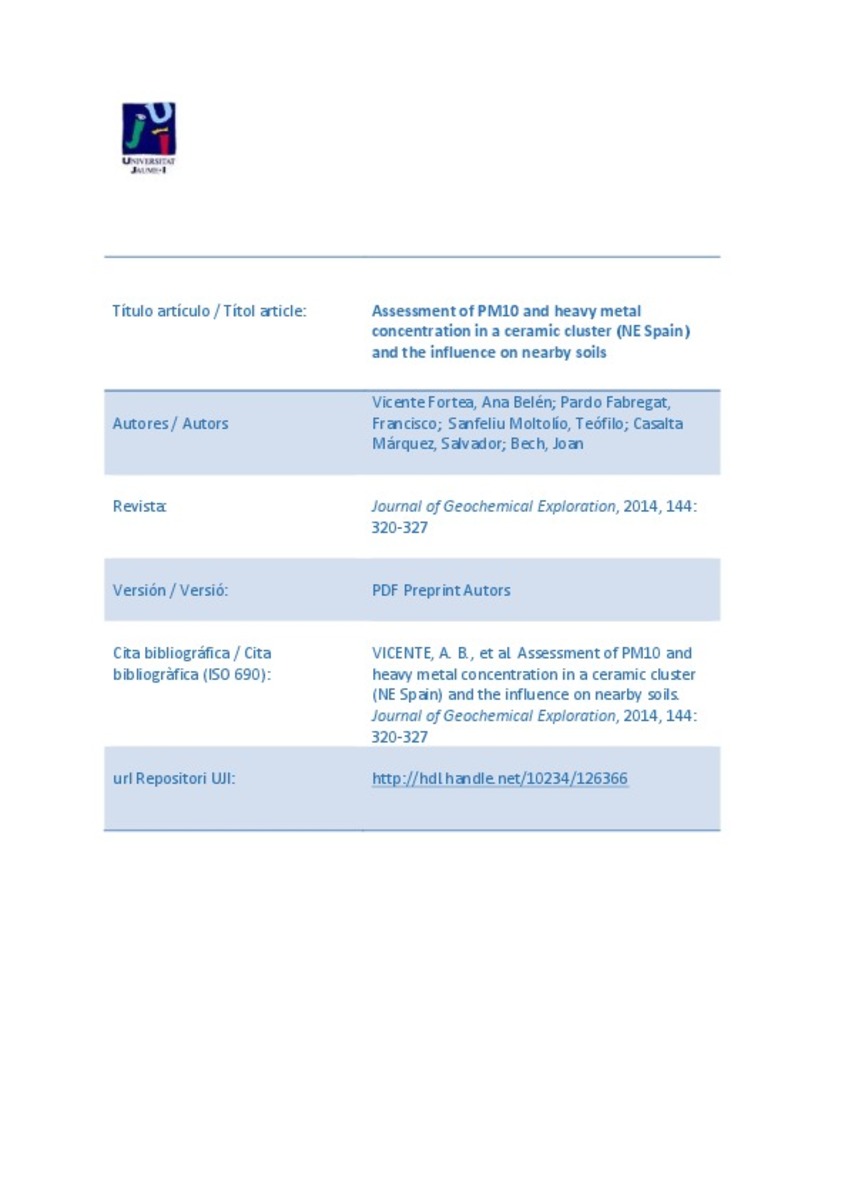Mostrar el registro sencillo del ítem
Assessment of PM10 and heavy metal concentration in a ceramic cluster (NE Spain) and the influence on nearby soils
| dc.contributor.author | Vicente, Ana Belen | |
| dc.contributor.author | Pardo Fabregat, Francisco | |
| dc.contributor.author | Sanfeliu Montolio, Teófilo | |
| dc.contributor.author | Casalta Márquez, Salvador | |
| dc.contributor.author | Bech, Joan | |
| dc.date.accessioned | 2015-07-06T11:43:01Z | |
| dc.date.available | 2015-07-06T11:43:01Z | |
| dc.date.issued | 2015-07-06 | |
| dc.identifier.issn | 0375-6742 | |
| dc.identifier.uri | http://hdl.handle.net/10234/126366 | |
| dc.description.abstract | Environmental pollution control is one of the most important goals in pollution risk assessment today. The aim of this study is to conduct a retrospective view of the evolution of matter particulate (PM10) and the heavy metals (Cd, Ni and Pb) at different localities (Alcora, Castellón and Onda) in the Spanish cluster ceramic in a period between January 2007 and December 2011. The study area is in the province of Castellón. This province is a strategic area in the framework of European Union Pollution control. Approximately 80% of European ceramic tiles and ceramic frits manufacturers are concentrated in two areas, forming the so-called “ceramic clusters”; one is in Modena (Italy) and the other in Castellón (Spain). In these kind of areas, there are a lot of pollutants from this industry that represent an important contribution to soil contamination so it is necessary to control their air quality. In these areas atmospheric particles are deposited in the ground through both dry and wet deposition. Soil is a major sink for heavy metals released into the environment. For this purpose the levels of PM10 in ambient air and the corresponding annual and seasonal trend were calculated. The results of the study show that the PM10 and heavy metal concentrations are below the limit values recommended by European Union Legislation for the protection of human health and ecosystems in the study period. There is an important reduction of them from 2009 in all control stations due to economic crisis and subsequent decrease of industrial activity. The atmospheric seasonal tendency of pollutant concentrations is marked by the rate of industrial activity and additionally by the temperature. Complementarily, a comparative study of heavy metal levels in soils was performed in this area. Soils with low pollution by Ni and Pb were detected, while different pollution by Cd was found depending on the sampling site. Although there is an evident reduction of PM10 and heavy metal levels, the results show that these pollutants have been accumulated in the soil close to emission sources. | ca_CA |
| dc.format.extent | 29 p. | ca_CA |
| dc.format.mimetype | application/pdf | ca_CA |
| dc.language.iso | eng | ca_CA |
| dc.relation.isPartOf | Journal of Geochemical Exploration, 2014, 144: 320-327 | ca_CA |
| dc.rights | Copyright © 2014 Elsevier B.V. or its licensors or contributors. ScienceDirect® is a registered trademark of Elsevier B.V. | ca_CA |
| dc.rights.uri | http://rightsstatements.org/vocab/InC/1.0/ | * |
| dc.subject | PM10 | ca_CA |
| dc.subject | Heavy metals | ca_CA |
| dc.subject | Soil pollution | ca_CA |
| dc.subject | Ceramic cluster | ca_CA |
| dc.title | Assessment of PM10 and heavy metal concentration in a ceramic cluster (NE Spain) and the influence on nearby soils | ca_CA |
| dc.type | info:eu-repo/semantics/article | ca_CA |
| dc.identifier.doi | 10.1016/j.gexplo.2013.12.015 | |
| dc.rights.accessRights | info:eu-repo/semantics/openAccess | ca_CA |
| dc.relation.publisherVersion | http://www.sciencedirect.com/science/article/pii/S0375674213002938?np=y | ca_CA |
Ficheros en el ítem
Este ítem aparece en la(s) siguiente(s) colección(ones)
-
CAMN_Articles [566]







